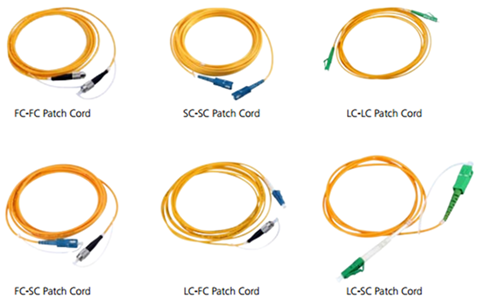Fiber Optic Patch Cord Knowledge
In the old days of grind-and-polish technology used in fiber optic communications, fiber patch cord installation seemed to be a difficult and hard-to get business which required a skillful specialist. But owing to the progress made in fiber optic terminations and technologies, fiber patch cables have seen extremely heavy use in telecommunications and wide area networks, since they feature high data rate capabilities, noise rejection and electrical isolation. Usually, fiber jumpers can be divided into two types: single mode patch cord and multi mode patch cord. Here “mode” refers to the transmitting mode of the fiber optic light in the fiber core. Usually the former, fiber optic patch cables single mode, are with 9/125 fiber glass typically with yellow jacket color, while the latter multi mode ones are with 50/125 or 62.5/125 fiber glass in orange color often.
Fiber optic patch cord is made of a fiber optic cable which is terminated by fiber cable connectors on both ends, meaning that fiber optic patch cable can be classified based on fiber optic connector types. For example, LC fiber patch cable means the fiber cable is with LC fiber optic connector. There are also PC, UPC, APC type fiber patch cord, different from each other because of the polish of fiber connectors. Fiber optic connectors are designed and polished in different shapes to minimize back reflection. This is particularly important in single mode applications. Typical back reflection grades are -30dB, -40dB, -50dB and -60dB. General use of these cable assemblies includes the interconnection of fiber cable systems and optics-to-electronic equipment. Image below shows several commonly-used patch cable types.

Compared with their copper wires, fiber optic jumpers have smaller diameter, lighter weight, easier for testing and installation. But their advantages are not limited to these points.
- Great Bandwidth
Fiber optic cables can carry very wide bandwidth signals, well into the GHz range. Many individual, lower bandwidth signals can be multiplexed onto the same cable. In commercial systems, fiber optic cable often carries a mixture of signal types, including voice, video and data all on the same fiber.
- Noise Immunity & Electrical Isolation
In industrial applications, one of the most important features of fiber optics is the noise immunity. Even in those conditions which are characteristics of prominent and unavoidable noise, fiber optics are unaffected. As for ground loop noise issues, the use of fiber optic patch cord can just eliminate it. Field signals, generated by devices floating at high potentials, can be coupled to other equipment at much lower potentials without the risk of damage. This is particularly preferable in industrial applications.
- Power Budget
While planning the fiber links, the most critical factor to be considered is the power budget specification of the devices being connected. This value tells you the amount of loss in dB that can be present in the link between the two devices before the units fail to perform properly. This value includes line attenuation as well as connector loss.
It’s necessary to mention that fiber optic patch cord is different from the fiber optic pigtail. The former consists of three parts: fiber optic connector+ fiber optic cable+ fiber optic connector, in contrast, the latter includes only two sectors: fiber optic connector+ fiber optic cable. Or put it in another way, when the cable is terminated with fiber connectors on both ends, it’s fiber optic jumper, and when the fiber connector is attached to only one end of the cable, it’s called a fiber optic pigtail.

Although fiber patch cords have been common for many years, there are still some myths about them.
Some people think that fiber jumper is more expensive than its counterpart copper. Actually, since manufacturing costs become down with each passing day, patch cord is less costly than the equivalent copper installation. Once deployed, the subsequent patch cord maintenance cost is also significantly less what copper requires.
It’s true that when terminating fiber cable, attention and care should be taken to avoid breaking the glass core, and some may think that patch cord is very fragile. But in practical use, fiber jumper has proven to be more robust than copper, able to withstand a higher pulling tension than copper, rated for larger temperature ranges.
Fiber patch cords play an important role in completing the end-to-end connections, ideally to be used in industrial and commercial systems. As professional fiber optic product supplier, Fiberstore offers various kinds of patch cords at affordable prices, including LC fiber patch cable mentioned above, SC patch cord, MTP/MPO cable, single mode and multi mode patch cords. If you want to know more information about patch cables or buy such cables for your networking use, please visit Fiberstore.